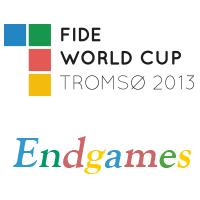
The Endgames of Tromsø, Part 4
At this point we know who won the World Cup - former World Champion Vladimir Kramnik showed that he was of a higher class and won the tournament very professionally. But we will continue to look at the endgames played throughout the tournament, now focusing on the fourth round.
By this point the number of contestants had already been reduced quite a bit, and there were not so many games being played. Of the classical-length games, there were only two which fit into the topic of the "Without the Lady" column - the first game of the Le Quang - Svidler match, and the second game of the Kramnik - Ivanchuk match.
Le Quang Liem's game against Peter Svidler went into a queenless middlegame as early as move eight. Le Quang got the better of it soon, with the black king unable to castle in a fairly open, symmetrical position. This variation might be practiced by those who are insistent on a Gruenfeld-type position (these queenless positions can arise in various ways in Anti-Gruenfelds), but other than that it looks like Black faces some problems with few winning chances. Eventually Le Quang made some inaccuracies and Svidler was able to hold with help from a positional exchange sacrifice.

Having lost the first game of their match with white, Ivanchuk needed to win as black against Kramnik - a tall order. He tried to create complications by answering 1.Nf3 with 1...b6. In fact, the position he reached was quite reasonable, but White was very solid. The queens were traded, an endgame was reached where White had doubled pawns. With good judgment, Kramnik fought back on the kingside, resulting in mutual pawn masses on opposite sides of the board. Kramnik nicely sucked the life out of black's game, and obtained the draw offer from Ivanchuk once Black no longer had any realistic winning chances and was perhaps a bit worse.

None of the matches Caruana - Granda Zuniga, Nakamura - Korobov, or Kamsky - Mamedyarov fit into my column, which only deals with positions where there is no queen. Caruana, Korobov, and Kamsky won in the classical games. Moving on to the rapid tiebreak games, there were several which fit the topic of my column. We will be looking at the most interesting.
Le Quang once again had the better position against Svidler in the first game of their tiebreak. However, a strange positional decision allowed Svidler to reach a position where his active pieces compensated for the pawn deficit.
In the second game, Svidler won a long ending in which his bishop and knight defeated the rook and pawn - thus Svidler advanced.
The match between Maxime Vachier-Lagrave and Boris Gelfand was pretty much decided in the first game of the tiebreaks. Gelfand got a nice advantage with black in the Gruenfeld, but at the wrong moment decided to begin active operations, rather than slowly improving his position. An endgame was reached, in which Gelfand apparently overpressed, passing by several chances to make a draw. In the end, Vachier-Lagrave's various passed pawns defeated the bishop.

In the second game of their tiebreak match, Vachier-Lagrave held the draw comfortably as black. We won't be examining that game.
None of the games from the Andeikin - Karjakin match met the criterion for the column. Dmitry Andreikin won in the first part of the tiebreaks.
Finally, there was the epic battle between Evgeny Tomashevsky and Alexander Morozevich. After drawing both classical games, they were also in the tiebreaks. Both of the first two rapid games ended in draws in opposite colored bishop endings. Here they are, without commentary:

With the match still tied, they moved on to ten - minute games. Morozevich won the first game, while Tomashevsky won the second in a huge 169-move battle. Neither of these games can be in my column - while the second game was and ending, it was a queen ending, and if queens start appearing in this column, I would need to chose a new name for it...
With the ten-minute games still tied, the players moved to blitz games. In the first of those, Tomashevsky won a ragged game as black.
And in the final blitz game of the match, a must-win for Morozevich (which would have forced the match into one more 'Armageddon' blitz game), an ending with each side having three connected passed pawns. Tomashevsky's were on the kingside (where both kings were located) and it turned out that, far from slowing down the pawns, the presence of the black king gave the white pawns more impetus. A draw was agreed due to repetition, although Tomashevsky could have delivered mate in one move! In any case, it didn't matter because a draw was all he needed to advance.
RELATED STUDY MATERIAL
- Read Part 1, Part 2 & Part 3 of The Endgames of Tromsø;
- Read IM Bryan Smith's series Exchange of Qualty — Part 1, Part 2 , Part 3;
- Read GM Grigory Serper's series A Rook or Two Minor pieces — Part 1, Part 2, Part 3, Part 4;
- Watch GM Dejan Bojkov's video Opposite Colored Bishop Endgames: Drawing Tendencies.






